Built-in wardrobes in the bedroom: varieties, tips for choosing and location

Built-in wardrobes for the bedroom are extremely popular, because they are very beautiful and can accommodate a huge variety of things in a very limited space. The main advantage of sliding wardrobes is that they are made exclusively for individual requirements and are adjusted as accurately as possible in size to the height of the ceilings and the width of the walls.






Peculiarities
The built-in wardrobe in the bedroom should be beautiful, functional and compact. The bedroom is a place to sleep and relax, so most famous designers advise to give preference to calm colors. Bright colors and an abundance of mirrored surfaces of furniture facades over time begin to cause discomfort to their owners.



The wardrobe can be equipped with a built-in lighting system, this solution is especially important if family members get up at different times. Due to the internal lighting, the need to turn on the light in the room will disappear, which will preserve a healthy sleep for a sleeping person.
It is advisable to divide the wardrobe into the female and male halves to save time looking for clothes and accessories.


The location and filling of built-in furniture must be very carefully thought out, because such a wardrobe cannot be rearranged from one part of the bedroom to another or moved to an adjacent room. It should be borne in mind that such furniture cannot be transported from one apartment to another.
The walk-in closet, in contrast to the built-in wardrobe, takes up much more space. Its main content is racks and bars with an open storage system (open shelves collect dust perfectly, all clothes and linen are in plain sight). The frame is not attached to the wall, but requires separate uprights. Inside the dressing room, space is needed for a floor-to-ceiling mirror and a pouf for seating. In addition to all of the above, a full-fledged lighting system will be needed, one illumination is indispensable here.



Advantages and disadvantages
Built-in wardrobes for the bedroom have their advantages and disadvantages, but their popularity is growing every day (many housewives dream of such furniture).
Advantages:
- built-in furniture allows you to choose the most convenient and functional content for the most rational use of the bedroom space and not clutter up the room;
- facades combine functionality with an attractive design for every taste in any color scheme;
- a huge selection of materials on the market for all constituent elements of the cabinet, including fittings;
- easy care of the lacquered or matted surface of the facades eliminates the need to use detergents, because it is enough to brush off the dust with a microfiber cloth;
- built-in furniture is a set of elements, each of which can be selected at your discretion;
- individual layout helps to make the most of the space in a small bedroom, and also helps to compensate for the shortcomings of the layout;
- sliding door system saves space as much as possible;
- a built-in wardrobe makes it easy to fit a huge amount of things (bed linen, clothes, accessories, household appliances and even shoes).

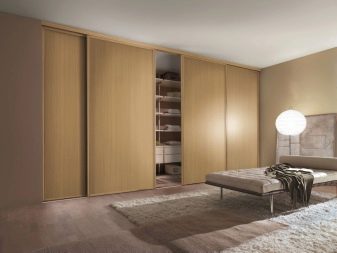


Disadvantages:
- size for a certain square of the bedroom, which makes transportation almost impossible when moving;
- installation to the full height, and often the width of the wall, which reduces the usable area of the room.


Views
Sliding wardrobes are straight (rectangular, full-length, usually located in a niche or between two windows) and corner.
Corner, in turn, are divided:
- L-shaped (two parts of the cabinet are connected in the corner, very important for a square bedroom);
- trapezoidal (with one side panel like a regular cabinet),
- triangular (mounted in a corner, straight facade);
- radius (with a round facade, they are very difficult to manufacture, therefore they are expensive).



A sliding wardrobe with a classic opening system needs additional space, and high doors make it necessary to add several sets of hinges for reliable fastening. The disadvantage of this option is the loosening of the mountings due to the frequent opening and closing of doors and the appearance of an unpleasant squeak.
The facade can have a different shape: it can be a concave or convex line, as well as a zigzag one.


The transforming cabinet differs from other types of built-in furniture in the absence of a ceiling and a back wall, such a structure must be fastened with anchors (this is the most convenient and less expensive option).
In the built-in wardrobes, you can make a stretch ceiling; it is best to combine the installation of the cabinet with the installation of stretch ceilings. Stretch ceilings require care, in addition, the boxes on the upper shelves of the cabinet can damage the coating, so you need to choose the most durable material for the ceiling.
You can build a TV, an audio system into the structure itself, leave a niche for a bed, equip it with spotlights outside or a diode tape inside for greater convenience.


Materials (edit)
Natural wood is environmentally friendly and quite well suited for the manufacture of facades of built-in furniture, but it is heavy and expensive, so it is rarely used.
Wardrobes are preferred from MDF (wood fiber board, compressed under maximum pressure). These boards are durable, presented on the market at very affordable prices and in a wide color spectrum.
With proper care, such material does not crumble, does not dry out, which contributes to the reliable fastening of fittings and shelves.

Chipboard (particle board) has an inhomogeneous structure, is very susceptible to drying and deformation, the edge is heavily peeled. Chipboard has only one plus - it is cheap, manufacturers of wardrobes most often use it precisely because of its low cost. Some manufacturers make products from scrap slabs, and over time, these doors and shelves delaminate.
Chipboard it is a laminated chipboard, it is slightly more reliable than chipboard.
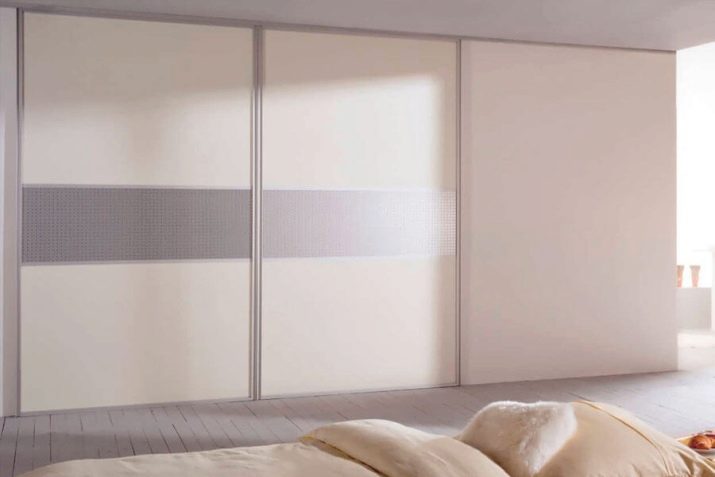
The most short-lived and difficult to install cabinets drywall, moreover, such a material needs additional coating.
Facades can be decorated bamboo, rattan, artificial leather, sandblasting. The appearance of the facades should be in harmony with the overall style of the bedroom.


Boxes are best to choose with a bottom made of thin chipboard (about 16 mm), sidewalls made of metal components. In order to extend the durability of the boxes, it is necessary to make a separate box to ensure maximum rigidity of the corners and preserve the beautiful appearance of the facades.
It is most advisable to fasten the shelves with a Euro screw and frame them with an S-shaped laminated profile that protects the edge surface from damage (other types of profile are unreliable and deform over time).

Sliding door systems are divided into the following subgroups:
- steel (cheapest) - inconvenient shape of the handle profile, the main load of the door rests on the vertically installed adjusting screw (its thread during operation can be torn off and block movement along the guides);
- hanging - a high-quality system is very expensive, and cheap options quickly fail (mirrors can come off, doors can fall out under the weight of their own weight);
- aluminum (the most reliable) - optimal in terms of price and quality ratio: thick walls, rigid profile (it is desirable that there is a stable thick anodized coating that allows you to maintain an attractive look for many years) with silent sliding doors and smooth running along the guides.
The rollers must be made of metal, plastic breaks down quickly, and for replacement it is necessary to remove the doors and completely disassemble them. An additional rubberized coating on the rollers helps to avoid extraneous noise during door operation.
Mirrors should be mounted on a safety film, if the mirror breaks, the fragments will remain in place.

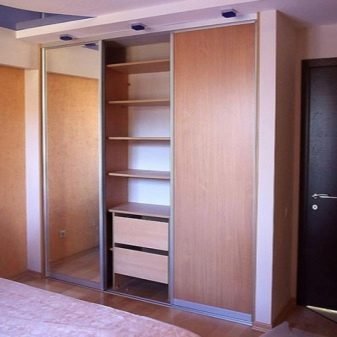
Sizes and shapes
The first step is to determine exactly where in the bedroom this structure will be located and what shape the finished wardrobe will be. When taking measurements, you must be very careful: it is necessary to measure the width and height of the walls from one edge to the other with an interval of 15-20 cm, often the walls have a distorted surface, and the size on the floor and ceiling can have discrepancies up to 10 cm. If in doubt, it is better to entrust the taking of measurements to a good specialist.
The standard ceiling height is 2 m 50 cm, but in reality there may be discrepancies of 5-10 cm, in some apartments the ceilings can be 2.7 m or 3 m, the stretch ceiling also changes the height of the room, therefore it is imperative to take measurements in the part of the bedroom where the wardrobe will be.

The depth of the closet usually ranges from 60 to 65 cm (stacked clothes will fit in 2 rows). If you need to place your clothes so that they are all in sight, it is better to give preference to roof rails instead of shelves. Clothes hanging on hangers wrinkle much less, which is an undoubted plus for housewives. It is better to leave shelves for bedding and underwear, towels, pillows and blankets.
Jackets and shirts are placed on hangers, for such clothes a height of 90 cm is sufficient, trousers are best stored on special hangers with clips, so they will not wrinkle, the required height in this case increases to 140 cm.

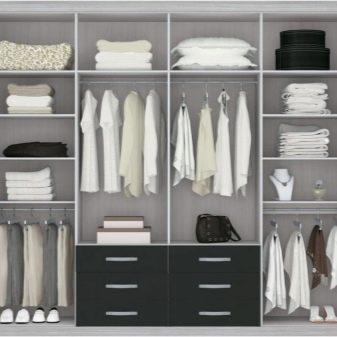
Internal filling
Internal filling (shelves, rails, drawers, niches for an ironing board, iron or vacuum cleaner, etc.) and the design of built-in furniture give full scope for the owner's imagination, and a list of simple rules will help beginners avoid mistakes.
Basic rules for filling a built-in wardrobe for a bedroom:
- niches, shelves and zones must be correctly combined;
- the top of the cabinet should be used for seasonal and rarely available items (umbrellas, hats, gloves, bags, etc.);
- the middle zone should be used for casual and seasonal outerwear;
- outerwear should be stored separately from everyday;
- underwear and bedding should have a separate part in the middle zone;
- the lower part of the cabinet can be used for shoes (if it is not possible to store them in the hallway, because storing outdoor shoes in the corridor is not only convenient, but also hygienic), boxes with household appliances, etc.


Necessary when designing take into account the needs of each family member (girls and women often have more clothes than boys and men), it is also advisable to take into account the presence of wardrobes in other rooms and their functionality so that the new built-in wardrobe does not turn out to be half empty.
You can add pull-out baskets, tie holders and other useful little things to the inner filling of the cabinet, according to personal preferences.
It is recommended to use open shelves for the closet in the bedroom only in case of emergency, it is better to put bedside tables for placing photos and various little things.

How to choose?
A trapezoidal or asymmetrical wardrobe can be built into a spacious room, and a straight or corner cabinet is best suited for a small room, which will save space as much as possible.
A built-in wardrobe with a TV is more suitable for a living room than for a bedroom; excess noise and information flows will not allow you to fully relax in the bedroom. In this digital age, it is necessary to leave a corner of personal space for reflection, relaxation and reading. The constantly flickering screen and emotional stress can cause nervous breakdowns, insomnia and depression.


For people practicing minimalism, one built-in wardrobe is enough for all family members, but it is necessary to carefully arrange its contents.
Facades must be in harmony in color and style with the design of the room.
It should also be remembered that glass and mirrored facades need more frequent and careful maintenance than ordinary ones; over time, even the most patient housewife can get tired of this.


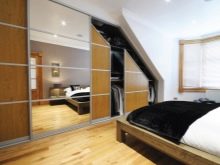
Location options
The built-in wardrobe in the bedroom can completely occupy one of the walls, be located around the door or between the windows, as well as in the corner.
Built-in furniture can include various elements (folding table, TV in the central niche, lighting system, etc.). In some countries, they even build in a folding convertible bed, which is removed in the closet during the day and looks like a normal facade when folded.


When choosing materials for the manufacture of a built-in wardrobe in the bedroom and its filling, it is necessary to find the perfect balance of price and quality. You can assemble such furniture yourself or hire experienced workers with a good reputation, who will help you take into account a lot of nuances and avoid mistakes, based on your practical experience.
Built-in furniture is designed to save space, decorate the interior, accommodate the maximum number of things and serve its owners for many years without causing any hassle.


Beautiful examples
Direct fitted wardrobe for the bedroom.

Corner built-in wardrobe.

Trapezoidal built-in wardrobe.
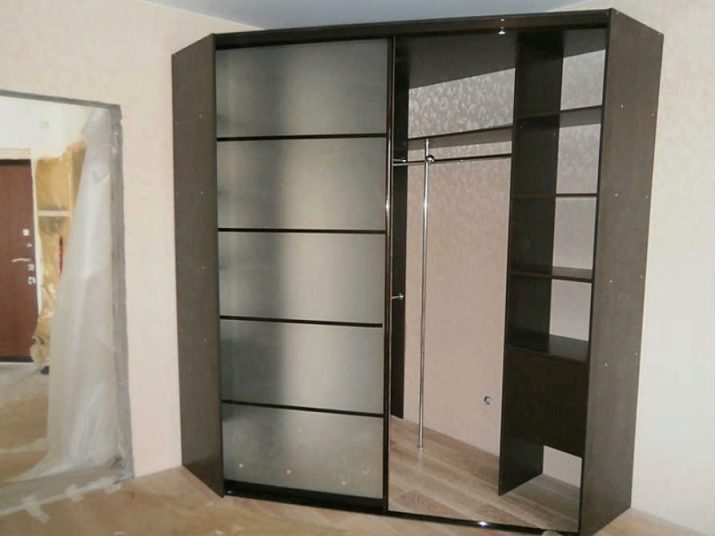
Radial built-in wardrobe.

Triangular built-in wardrobe.

For an overview of the built-in wardrobe in the bedroom, see the following video.








